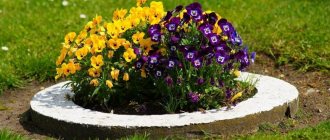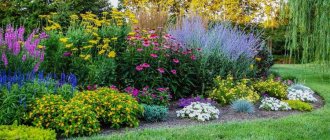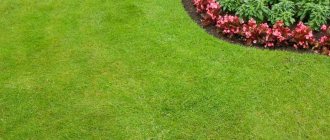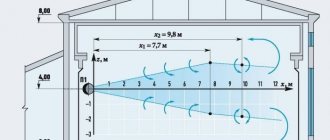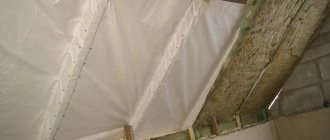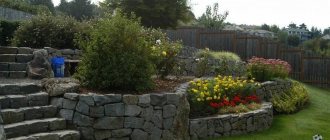Photo: w-dog.ru Every gardener creates his favorite flower beds like a real artist - carefully selecting colors and composing a composition. But in order for the flower garden to be not only beautiful, but also healthy, you need to correctly combine varieties. Consider the specifics of the soil, the amount of sun and shade, humidity and other nuances. And we are ready to show you many options for perennial and annual flowers!
Suitable plants
If the mixborder is placed near the fence, then the selected tall plants are planted in the background, and miniature ones in the foreground. A corner flower garden is created using the same principle. On rectangular, round mixborders and flower beds located on hillsides, tall plants are located in the center, medium-sized specimens (no more than 60 cm in height) are planted next to them, and dwarf plants (no higher than 40 cm) are planted at the edges.
High
Phlox will look good in the center of the composition
In the mixborder, tall specimens, called skeletal elements, are initially planted. Depending on the location of the flower bed, such plants can be located in the center or in the background, but they should not overlap low-growing specimens. It is not necessary to adhere to symmetry when planting tall perennials
When forming a mixborder, it is recommended first of all to pay attention to the following tall herbaceous plants:
- phlox;
- mallow;
- American asters;
- clematis.
Shrubs such as lilac, viburnum and cinquefoil also look good in a mixed flowerbed. An excellent background for flowering specimens will be conifers such as Korean fir, juniper and Lawson cypress.
Medium height
Snow-white lilies will stand out beautifully against the background of other plantings
On the second tier there are medium-sized plants that cover the elongated branches of the skeletal elements. The main purpose of such specimens is to smooth out the difference between tall and short plants. Perennials with decorative foliage, such as juniper, cineraria and geranium, will help create a smooth transition. You can create bright accents using the following medium-sized plants:
- roses;
- delphiniums;
- asters;
- peonies;
- chrysanthemums;
- lilies.
Dwarf
Variegated irises can be planted in the foreground
The third tier is made up of dwarf specimens and ground cover plants. It is advisable to plant unpretentious low-growing perennials in front, such as:
- irises;
- Pushkinia;
- horned violets;
- hosts;
- hybrid carnations;
- galanthus;
- bells;
- asters.
Alstroemeria
Many people confuse this amazingly beautiful plant with a lily, and even confidently claim that the alstroemeria flower is one of the small species of the Daylily family. This plant is rightfully considered one of the most beautiful, since a large number of bright inflorescences give alstroemeria luxury and aesthetic value. Plant parameters can be moderate and be approximately 70-80 cm, and figures over one and a half meters are also not uncommon. The petals fit together in such a way that the funnel really resembles a lily. It is noteworthy that on one peduncle, a whole “bunch” of inflorescences, 5-6 pieces, is simultaneously formed, giving the flowering shrub chic and incredible beauty on the site. Against the background of the inflorescences, green foliage of a narrow shape and large quantity harmonizes well.
- Alstroemeria in yellow shades, represented by such varieties as Golden, Nano, Lisa, Garden Jewel Yellow, Lutea, are considered incredibly beautiful.
Forms of flower beds: artistic solution
Idea for a flower bed in the garden
Fantasy regarding the shape of flower beds can be limited only by the size and characteristics of the plot of land on which the flower bed is to be planted.
There are no restrictions in either horizontal or vertical arrangement: circle or square, rectangle or oval, alpine slide or green wall - whatever the owner likes.
Let's take a closer look at horizontal flower beds and try to decide not only on the shape, but also on the restrictions imposed on the selection of plants.
Circle and oval
Oval flower bed of perennials
This geometry of flower beds is perhaps the most common due to the perfection of forms and simplicity of arrangement of plants.
Concentric circles or ovals that define the boundaries of groups of flowering plants allow you to create an amazingly beautiful composition when flowering, starting from the outer perimeter, gains strength and reaches a peak in the center.
These same shapes make it possible to group plants so that flowering periods alternate, creating the impression of iridescence.
Such figures are also good because radial paths for caring for the flower garden naturally fit into them. There are no restrictions on the choice of plants, since shrubs and trees can be planted in the center, and herbaceous ones along the edges.
Scheme of a round flower bed of continuous flowering
Square and rectangle
Design of a square flower bed in front of the house
These simple shapes are of interest for creating original and colorful patterns inside the perimeter: broken polyhedrons or rounded compositions create the unique appearance of a flower bed.
In addition, the simple external geometry allows you to literally paint pictures or lay out a mosaic of low plants.
In this case, there are no obstacles to the choice of perennials and annuals: perennial shrubs can be placed in the center of the composition, and low-growing perennials that bloom all summer along the perimeter.
Triangle and star
Decorating a garden plot with triangular flower beds
By themselves, single flowering triangles look less impressive than if you combine their shapes into groups of irregular geometry or, conversely, give them regular graphic shapes, for example, stars. Such a flower garden will not leave anyone indifferent.
True, it’s worth tinkering with the selection of plants here: the most optimal and spectacular will be herbaceous species of perennials (oak anemone, mountain arena, astilbe, asters, etc.).
Irregularly shaped flower beds
A well-designed flowerbed of continuous flowering perennials
But still, the most advantageous option for complementing and decorating the landscape design of the area in front of the house will be irregular flower beds.
The reasons for their success are that they fit perfectly into an inconvenient landscape and help to avoid “bald patches” formed by plants that do not flower for a certain period.
Let's consider the features of constructing an asymmetrical flower bed of continuous flowering:
First of all, the viewing points of the flower bed are determined, and based on this, the problem of grouping plants is solved. Plants are planted so that there are low plants in the foreground and tall plants in the background, which should not block the overall view of the flower arrangement.
Please note: the planting height in an asymmetrical flower garden should be 2 times shorter than the distance to the place from which the view opens. Plants are selected and grouped in accordance with their optimal growing conditions: lighting, soil composition, watering needs
Within the group, zones are formed in accordance with the flowering period. Uniformity in the volume of plants blooming at different times is maintained
Plants are selected and combined into groups in accordance with the optimal conditions for their growth: lighting, soil composition, need for watering. Within the group, zones are formed in accordance with the flowering period. Uniformity in the volume of plants blooming at different times is maintained.
Photo example of contrasting design of a flower bed of perennial flowers
When forming the geometry of space, the speed of vegetation of different species is taken into account. The selection of species is carried out in accordance with a certain color scheme. In one case it will be a contrasting combination, in another it will be a color gradient, and in the third it will be similar shades.
Places from which it will be convenient to maintain and replace plantings are determined. Faded plants often lose their attractive appearance.
Petunia
She is quite capricious and requires appropriate care. Modern technologies and innovations make it possible to obtain a huge variety of colors, which will differ in shape and size.
Some species prefer high humidity, while others, on the contrary, thrive in sunny areas. These flowers are used to create flower beds that bloom all summer.
Garden chairsHow to plant and grow an oak tree from an acorn at home
A beautiful rose garden in the country - step-by-step instructions with photo examples of designing a rose garden in the garden!
Timely watering and fertilizing ensure continuous flowering.
Flowerbed design with perennial flowers
You won’t surprise anyone with simple flower beds. Plants are planted not only in open ground, but also in various objects raised above the ground. They are often made in the same style as a terrace, veranda, swimming pool, or the nearest building. In just a couple of hours, any item that has been collecting dust in the barn can turn into an original landscape design object.
A flowerbed that blooms all year round is every gardener's dream.
The following types of flower beds can decorate your garden:
- Regular flower bed. Plants are arranged symmetrically, tightly, in even blocks. Flowers must have one flowering period and height. Hybrids are more suitable for this purpose;
- Irregular flower bed. A free-form flower garden with perennials that bloom alternately throughout the season;
- Carpet flower bed. The close arrangement of low-growing plants creates a carpet effect. Various inert materials (pebbles, sand) will help create a clear pattern. The most popular design example is the flower clock;
- Raised flower bed. A non-standard flower garden is raised above the ground by 20-100 cm. It can be in one or several tiers. A combination of ground cover and tall plants is possible;
- Vertical flower bed. Used to save space. Place it on the ground, hang it, attach it to any surface. The main advantage of this design is that there is no need for weeding;
- Multidimensional flower bed. The unusual flower garden is located not on a plane, but in volume. To create compositions, auxiliary structures are used. For example, a flowerbed made from an inverted umbrella, on a chair, in a cart;
- Ring flower bed. They are located in a ring around an object (tree, bush, large stone). To prolong the bright color, plants alternate according to the flowering period;
- Island flower bed. Includes plants of varying heights. The tallest perennials are in the center, low-growing along the edges; Flowerbed-panel. A complex flower garden resembles a carpet bed and reflects a specific image or inscription;
- Modular flower bed. In one space, flower beds unite individual areas with one idea. They are separated by slabs and paved paths.
Groundcover varieties
In addition to low-growing perennials, there are many groundcover varieties of decorative flowers that are capable of forming carpets of inflorescences. They are unpretentious in care, soil composition and lighting.
The most popular are:
Landscape Design Basics
Having an idea of landscape design is necessary in order to create a real work of art from your vegetable garden or garden. Landscape architecture is based on several important principles:
- Unity;
- Simplicity;
- Choice of dominant;
- Rhythm;
- Geometry and smoothness.
How to create a flowerbed of continuous flowering
Unity
Unity must be present throughout the territory. This principle is set from the most important object in the garden, namely the house. The style of the residential building should be followed in the garden. This also applies to flower beds. A constantly blooming flowerbed should correspond to the dacha.
If the house is very ordinary, then it is better to plant meadow plants in the flower garden. Another option in this case is to plant edible crops that look attractive. For example, you can plant ornamental cabbage, cauliflower, chocolate mint, lemon balm, curly parsley, etc. They will clearly highlight the features of your garden.
If the house is brick, built in a simple style, then the flower garden should be built classic and discreet. To do this, the gardener abandons pomp and pretentious brightness and chooses noble, calm tones and shapes.
Unity of colors
Simplicity
This category means the absence of pomposity and emotional overload. Don't overdo it with details. The most attractive and attractive garden areas are organized simply but tastefully. Extra elements will make the garden untidy.
Choosing a dominant
Here we are talking about the fact that there cannot be several main elements in one territory at once. Otherwise they will outshine each other and the picture will become blurry.
It is important to choose one dominant and build a design taking into account subordination to the main object. The dominant can be a pond, stream, spreading tree, bush of unusual shape, etc. When arranging a flower bed, it is also necessary to decide on the dominant plants around which the subordinate crops will be located
When arranging a flower bed, it is also necessary to decide on the dominant plants around which the subordinate crops will be located.
Rhythm
The rhythm of the garden is created through the repetition of certain motifs. An example of rhythm - in different parts of the garden there are the same dwarf trees, columnar apple trees, standard currants, etc.
Patterns of continuous flowering beds
Geometry and smoothness
Geometry involves creating clear lines in the garden and subordinating the vegetation to geometric shapes. For example, berry bushes will be planted in a square shape; paths, platforms, fences, hedges will be straight or with clear angles.
Fluidity is the opposite of geometry in garden architecture. Gardeners who are tired of the clear lines of the city resort to it. Therefore, all objects in the garden area are supposed to be smooth, soft and flexible.
All these principles directly apply to mixborders (combined flower beds). However, you should not strictly follow each of them in order to create a mesmerizing composition. These are not rules, just tips. Each gardener ultimately creates his own unique flower garden from plants that are his favorites.
Calceolaria
It is a low-growing plant that prefers shaded areas in the garden. These flowers prefer high humidity with proper watering rules.
It is forbidden to water the plant from above onto velvety leaves. This contributes to the appearance of burns and loss of decorative appearance.
Flowerbed for beginners
To plant a flower garden of perennials yourself, you need to adhere to the following principles:
- In the central part of the flower garden, tall plants are used: roses, asters, lilies, peonies, phlox, lupins, clematis, meadow bells, echinacea, daylilies.
- Medium-sized perennials complement tall flowers. Medium-growing ones include tulips, irises, cornflower, catnip, sage, yarrow, lavender, primrose, and fern.
- The edges of the flower bed and gaps are decorated with ground cover plants. Among them are chickweed, periwinkle, Renard's geranium, carnation, navelwort, lungwort, and speedwell. The cushion aster looks good.
Particular attention should be paid to the flowering time of certain plants. It is necessary that the flowerbed retains its beautiful appearance all season long.
Here are some examples of when the varieties used in flower beds bloom:
- Pink paniculate phlox. It is better to plant it in early spring or autumn in sandy or well-drained soil. The plant blooms from mid-summer to autumn.
- Pink astilbe. The flower loves fertile, loose soil. Blooms from late June to August.
- Purple-silver daylily. It is planted in spring in fertilized and well-drained soil. Loamy soil with an acidity of 6-6.5 pH is suitable for it.
- Lavender Heuchera. Blooms from May to July. Loves soils without stagnation.
- Geranium. It blooms from July to autumn and is distinguished by its lush form.
Tall flowers can be planted singly, while small ones are best planted in groups. In this case, you need to look at the flowerbed from different sides of the garden, and from everywhere, tall flowers should be visible in the center, and low-growing flowers should be visible at the edges. To avoid bald spots, plants are planted close to each other, but not crowded.
Before you start creating a flower bed, you need to draw up a suitable plant arrangement. You can do this yourself, or you can take ready-made patterns of flower beds from perennials, developed by specialists.
Flowerbed in the shape of a heart
You can create flower beds of various shapes. One option is heart-shaped flower beds. The outer borders are decorated with peonies in pink and burgundy tones, planted in turn. You can plant roses inside.
Flower garden Sky in the clouds
A delicate romantic flowerbed consisting of three types of flowers. The first stripe is a combination of Transcarpathian bellflower and gentian, the second is white phlox. Such a flowerbed will make any area warm and welcoming.
Perennials that bloom in the first year
This flowerbed option is suitable for those who do not want to wait a whole year before the first flowering. For this purpose, plants are selected that bloom immediately after planting in the ground. Scheme for constructing such a flower bed:
- Two-year-old hollyhocks in yellow and white are planted in the background.
- Sunflower complements mallow.
- St. John's wort and Irish poppy are located in the flower bed and form bright spots.
- Cardinal lobelia is planted in the center; this flower has a lush, beautiful bush.
- Along the edges of the flower bed are Poskharsky's bell, Fassin's catnip and Kalanchoe.
- Gravilat decorates a flower garden in the summer, and chitok in the fall.
Flowerbed of continuous flowering depending on the season
To make a flower garden of continuous flowering, it is necessary to take into account the seasonal characteristics of plants.
In the spring, after the snow melts, wolf bast bushes begin to bloom. Crocuses, scillas, and irises are blooming in the flowerbed. Later, tulips, daffodils, marigolds, and liverworts will bloom. Then irises, phlox, speedwells, daisies, and violas bloom. Peonies, sage, and spurge join in May. Hostas and sedums decorate the flowerbed.
In summer, the flowerbed blooms with new colors. Catnip, chistets, and shower are blooming. Geraniums of different types will delight the eye for a long time. There are daisies, bluebells, eryngium, rudbeckia, alpine aster, and hydrangea. Maiden grapes and hops will look good in the background.
In the fall, sage and catnip will bloom once again. Geranium is still beautiful. Hostas, spurges, rudbeckias, and aster delight with their splendor. Chrysanthemums, coreopsis, and colchicums are blooming, adding autumnal charm to the flower garden.
A winter flower bed can also be beautiful with evergreen arborvitae, left behind cereals and installed sculptures and flowerpots.
These are the basic rules for designing a flower bed of continuous flowering; the diagrams help beginners create an attractive flower garden with their own hands.
Duchesnay
It is a fast-growing ground cover plant that needs constant sunlight. The plant is unpretentious and does not require proper care. It is enough to water it and spray it during hot periods.
The inflorescence bears some resemblance to strawberries. At the end of flowering, fruits are formed that look like strawberries.
Create a continuously blooming flower bed
When arranging a flower garden, think about the choice of location and its size.
It is important to place it so that it not only looks appropriate in the landscape design, but is also favorable for the growth and flowering of each planted perennial. Therefore, you need to start arranging living decor with a schematic drawing
It details where each plant will be planted.
Beautiful high flower bed with perennials of different heightsSource vsaunu777.ru
Color selection
For long-term flowering of the flower bed, you need to take care of choosing plants that bloom earlier in the season: at the beginning of summer, middle and end. After all, the average flowering period of any perennial is no more than 3-4 weeks. One flower bed can contain low-growing and tall ornamental crops well.
- Astilbe. A perennial plant that is classified by variety. It can be stunted and have tall shoots. Grows well in shady areas and is not afraid of direct sunlight. It differs in shade and method of flowering: panicles can be small or large. This variety will add emphasis to the flower garden. The inflorescences do not fall until 7-10 weeks.
- Helenium has different varieties: two-color, compact, early. They grow well and bloom for a long time in sunny or slightly shaded places on the site, for example, under a lush tree, where there is no sunlight only in the morning or evening. The plants are frost-resistant and do not require replacement for 5-7 years. They need humus in the fertile soil layer.
- Geranium is magnificent. It is chosen for flower beds on the site for its large inflorescences. They stand out clearly against the background of other low-growing crops. Grows well in partial shade, withstands frost, and combines with other perennials. It blooms from May to June, then delights with its pointed leaves.
- Catnip. The plant does not need fertilizer and does not take over the properties of the soil, depriving other plants in the flower garden. Blooms with lush buds in bright sunlight. It also feels good in the shade. The culture is considered unpretentious and is not afraid of moisture and frost. Blooms from mid-June to the first ten days of July.
- Oriental poppy. Has fairly large flowers. There are several varieties. Some bloom in May, others in June-July. The plant tolerates winter cold well, grows on the windy side of the yard, and does not require special care other than watering.
- Cuff. An unpretentious plant for a flower bed. It has beautiful leaves with a jagged edge. It reaches a height of 35-70 cm, the inflorescences are yellow and neat. Flowering duration is early to late summer. The culture can be propagated through the root system or by self-sowing.
- Sedum. The plant has a fast propagation method. It is not demanding on fertilizer, it grows in any conditions: on acidic, clay soil. It is distinguished by lush flowering when planted in black soil in the shade or partial shade. Requires systematic watering if precipitation is rare in the region. Flowering from mid-summer (late July-early August) until late autumn (October-November).
- Rudbeckia. The plant has many varieties. They differ in the shape of the leaves, buds and shade of flowering. It can reach a height of up to 2 meters. It blooms for a month and a half, usually this period falls in June-July. It all depends on the time of disembarkation. Planted by seeds or by dividing the root system. Preferred to rich soil. Requires light, nutrient-rich soil. Grows well in flower beds with regular fertilization.
- Yarrow. Not demanding on care and maintenance, color in the form of baskets from June to September. The regularity of watering is chosen depending on the degree of drought. In moderately humid climates, two to three times a week is sufficient. Has up to 150 varieties. In Russia, common yarrow is used, its height is 1-1.5 meters. Grows well in well-lit areas on the site.
- Hosta. This is a shade-loving perennial plant. It is watered at least three times a month. Has several varieties. Propagated by dividing bushes. It blooms singly, the flowers appear on tall stems and are pale yellow, beige, pink, and less often purple. It begins to bloom in May, provided it is not sick or affected by pests.
- Japanese anemone. An unpretentious beautiful perennial. Flowers come in a variety of colors. They look good both in the center and at the border of the flower bed. The stems can reach 1 meter in height. It begins to bloom at the end of summer and ends at the end of autumn. An ornamental crop is planted in open ground.
When choosing plants, you should not plant them all at once. Focus on those that have an adjacent flowering period and differ in color.
Flower garden on the lawn with daylilies and daisiesSource build-experts.ru
Calla
This is the main representative of the Araceae family, which has a unique and very original flower that consists of a kind of “cob” that “covers a blanket,” which is what calla lily inflorescences are often associated with. The plant itself is moderate in size, with averages not exceeding 80 cm, although there are also taller representatives. The foliage is very large and massive, located closer to the ground. The length of the average leaf can reach 30 cm, but the width is almost 25 cm. Many compare the shape to an arrow, since leaves of large diameter always have a sharp tip, like an arrow. The color scheme of calla lilies is usually white, but there are also very beautiful yellow varieties that can make your flower garden incredibly beautiful.
- Famous varieties of yellow calla lilies are Elliott, Black Magic, Captain Morelli, Pot of Gold, Best Gold, Florex Gold.
How to plant?
Even those who have just begun to learn the basics of the art of landscape design can organize a flower garden or flowerbed with their own hands at the dacha, if they take the matter seriously. At the initial stage, garden crops are selected according to the time of planting and thus a list is formed that includes spring, summer, and autumn varieties.
Proper arrangement of a flower bed also involves determining and researching a place for planting: you need to analyze the soil, lighting in individual parts of the flower bed and find out whether there is a slope. This is necessary for the correct placement of crops, taking into account the requirements of green plants for light and humidity conditions, the composition and condition of the soil.
To avoid mistakes when planting, a diagram is drawn in advance with the compositional arrangement of selected plants in certain places according to the previously defined criteria:
- Requirements for agricultural technology. The plan should have a clear distribution of shady, shaded and well-lit areas for planting.
- Decorative: some crops will form the structural basis of the flower garden, others - conifers, deciduous shrubs and perennials, will act as a spectacular frame for flowering neighbors.
- Size. If the club is adjacent to fences or a house, then large plants are planted in the background, and medium-sized varieties and miniature groundcovers are given places in the front rows. When a flower garden (round, oval) is placed in the middle of the house territory, its center can be decorated with tall plants. Narrow-leaved flowers and grasses alternate with broad-leaved ones.
- Seasonality of flowering. In this case, it is convenient to navigate according to the blooming and fading schedule of summer, spring, and autumn plants selected for planting. Each time period should correspond to flowering periods of at least 3-4 flowers.
- Coloring. When choosing a color solution for flower beds, they are guided by personal preferences, while not forgetting the general rules of color combinatorics - either as a complement or for contrast.
The last stage is preparing the soil for planting: applying fertilizer mixtures and disintegrants - expanded clay, crushed brick, river sand. The growth of actively growing varieties is limited with the help of plastic fences, deepened into the ground near the landing site of aggressive green pets.
And in the next video you can familiarize yourself with the main mistakes when designing flower beds.
Marigold
This species is distinguished by its unpretentiousness and decorativeness. The plant can live in any soil. During the flowering process, up to 15 inflorescences of a bright orange hue are formed on the bush.
Upon contact, a distinct odor is felt. Plant flowers in well-lit areas.
Scheme
To create a living carpet on your site, you will need a diagram and low-growing flowers. It is thanks to such plants that the effect of a voluminous bright pattern will be achieved.
Experts recommend choosing flowers of the same type so that the carpet does not contain elements that differ in size or unusual shapes. Please note that the flowering should be dense so that no gaps are visible.
It’s not at all difficult to create a flower-shaped composition with your own hands. For this you will need phlox and aquilegia. Plant white phlox along the edge; purple and pink phlox will appear in the form of flower petals. A yellow aquilegia will look great in the middle of the composition. Lush phlox flowers will perfectly cover the ground and create a three-dimensional picture.
Flower beds made from perennials - low-growing or medium-growing plants - look spectacular in the country.
It is not recommended to use tall plants, since the design can only be seen from a height. It’s easy to make a “heart” composition. Make the outlines of the design from peonies, which are popular due to their splendor and brightness. Inside, the space can be filled with luxurious roses.
When choosing shades, you can give preference to pink tones. Compositions in the form of islands, which do not require clarity, constant care, and their creation does not require much time, are popular. Such flower beds can be made single-color or multi-colored.
The second solution will be appropriate for those who love bright colors and want to make their garden plot original.
The flowerbed-island includes plants of different heights. So, for example, on the left side of the composition, plant low-growing bright perennials - soapwort. Place the gentian on the right. Daylily bushes will also look good in the middle right, and place several rose bushes between them. Fill the middle left side of the composition with stock roses. And decorative sunflowers will look great in the remaining space.
Border flower beds at the dacha will become a source of pride for their owner. Among the following schemes you can choose the one that suits you:
- “sky in the clouds” – place Carpathian bell and gentian along the border, fill the second row with white phlox;
- “The beauty of pink” - plant aubrietas and soapwort in a row in any order;
- “royal” - the combination of yellow roses and Carpathian bell looks really luxurious;
- “brightness and tenderness” - plant yarrow in the 1st and 3rd rows, and fill the space between them with daylily;
- “extraordinary” - place purple aquilegias along the border, followed by lilac phloxes.
Such original flower beds will delight their owner with bright colors, and will delight all guests, relatives and passers-by.
sedum
He prefers sunny areas. Plants do not require timely feeding or frequent watering.
In winter, he can do without additional shelter. During the flowering period, long inflorescences of a bright pink hue are formed.
Creating a flower garden
When the flowerbed option is chosen, it is necessary to begin creating it in reality.
You need to start preparing the soil in the selected area, in which:
- Remove garbage and dispose of existing stones;
- Eliminate all possible pests;
- Dig the soil 50 cm deep;
- Get rid of weeds.
When the area is cleared and prepared, it is fertilized with various types of mineral fertilizers. Create a drainage layer 15 cm high using crushed stone, sand, and gravel.
When the soil is prepared and fertilized, it is leveled. The height of the soil above the ground for the life of the flower garden should be within 10-15 centimeters, so the water will not stagnate, and the soil will be well saturated with air.
In conclusion, we can say that perennial flower beds are an art form that everyone can do. In this matter, the main thing is to have a desire, and to follow the advice of professional gardeners who have been creating flower bed compositions for years, based on their experience and knowledge. Ready-made flower bed designs will help make your dream come true and create a small masterpiece in your garden, despite all the obstacles. And if you decide to create your own flower garden without the proposed options, then everything is in your hands.
alpine aster
It is a herbaceous plant whose height reaches from 15 to 35 cm. It prefers partial shade and regular watering. The flowering process lasts from 1 week to 3 months.
